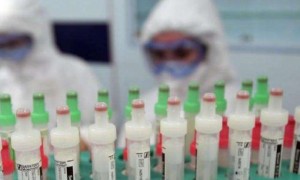Entry overview: The female reproductive system includes internal and external reproductive organs and related tissues. Female external genitalia refers to the exposed part of the reproductive organs, also known as the vulva. Including the mons pubis, labia majora, labia minora, clitoris, vestibule, bartholin gland, vestibular bulb, urethral opening, vaginal opening and hymen. Female internal genitalia, including vagina, uterus, fallopian tubes, and ovaries.

Basic Information
Chinese name: Sexual organs
Foreign name: sixer
Attribute: reproductive organs
Use: Sexual reproduction
Explanation: The tissues that make up the reproductive system
SRY gene: uterus
Introduction
Female external genitalia refers to the exposed part of the reproductive organs, also known as the vulva. Including the mons pubis, labia majora, labia minora, clitoris, vestibule, bartholin gland, vestibular bulb, urethral opening, vaginal opening and hymen.
Female internal genitalia, including vagina, uterus, fallopian tubes, and ovaries. The vagina is the channel for the discharge of menstrual blood and the expulsion of the fetus from the mother, and it is also the sexual organ. The uterus is the place where the fetus is conceived. The fertilized egg implants here and gradually grows and develops into a mature fetus. After full term, the uterus contracts and the fetus is delivered. During the period from puberty to menopause, if there is no conception, the endometrium will undergo periodic changes and exfoliation under the action of ovarian hormones, resulting in menstruation. The fallopian tubes function to transport sperm and eggs, and are also where sperm and eggs meet for fertilization. After fertilization, the pregnant egg is transported through the fallopian tube into the uterine cavity for implantation. The ovary is a female's gonadal organ. There are many follicles in it, which can produce and release eggs, secrete sex hormones, and maintain female-specific physiological functions and secondary sexual characteristics. After menopause, the ovaries gradually shrink.
The composition of the external genitalia
1. Mons pubis: Located in front of the pubic symphysis, there is abundant adipose tissue under the skin. At the onset of puberty, the skin on it begins to grow curly pubic hair, which is one of the secondary sexual characteristics.
2. The labia majora: a pair of raised skin folds on both sides of the vulva. It is connected to the mons pubis in front and the perineum in the back. The labia majora is rich in adipose tissue and venous plexus under the skin, and it is easy to form hematoma after local injury
3. The labia minora: located on the inside of the labia majora. It is a pair of longitudinal skin folds, with a moist surface, resembling mucous membranes, brown in color, hairless, and rich in nerve endings, so it is extremely sensitive.
4. Clitoris: Located in front of the labia minora. As cavernous tissue, the clitoral head is rich in nerve endings and is extremely sensitive.
5. Vaginal vestibule: The diamond-shaped area between the two labia minora. The front of the vestibule has the urethral opening and the rear has the vaginal opening.
(1) Urethral orifice: It is an irregular oval hole located between the clitoris and the vaginal opening. There are a pair of glands on both sides of the back wall of the urethra, called the paraurethral glands, which are often where bacteria lurk.
(2) Bartholin's gland: also known as Bartholin's gland. Located at the back of the labia majora, are the glands on either side of the vaginal opening. Large like a soybean; the glandular duct is slender from 1 to 50px and opens in the groove between the labia minora and the hymen. When sexually excited, it secretes yellow-white mucus for lubrication. this gland should not be palpated during normal examination. It can be seen or palpated if an abscess or cyst forms due to occlusion of the duct orifice due to infection.
(3) Vestibular bulb: Also known as bulbocavernosus, it is located on both sides of the anterior lip and consists of erectile venous plexus, and the surface is covered with bulbocavernosus muscle.
(4) Vaginal opening and hymen: The vaginal opening is located below the urethral opening, and the vaginal opening is covered with a thin film called the hymen. There is an opening in the center of the membrane. Menstrual blood flows out of this.
3. Composition of internal genitalia
(1) vagina
It is the channel for the sexual organs, the discharge of menstrual blood and the delivery of the fetus.
1. The location and shape are located in the center of the lower part of the true pelvis. It is a pipe that is wide at the top and narrow at the bottom. The anterior wall is 7-225px long, adjacent to the bladder and urethra, and the back wall is 10-150px long, close to the rectum. The upper end of the vagina surrounds the cervix, and the part that surrounds the cervix is called the vaginal fornix. According to its position, it is divided into four parts: anterior, posterior, left and right. Among them, the posterior fornix is the deepest and is closely adjacent to the rectum-uterine depression. It is the lowest part of the pelvic cavity, and can be punctured or drained clinically. The lower end of the vagina opens at the back of the vestibule.
2. Organizational structure The vaginal wall is composed of mucous membrane, muscular layer and fibrous tissue membrane. There are many transverse folds, so it has great extensibility. The vaginal mucosa is pale red and covered by stratified squamous epithelium without glands. The vaginal muscle layer is composed of two layers of smooth muscle fibers, the outer layer is longitudinal, the inner layer is circular, and there is a layer of fibrous tissue membrane outside the muscle layer, which contains a lot of elastic fibers and a small amount of smooth muscle fibers.
The vaginal mucosa is subject to cyclical changes under the influence of sex hormones. The vaginal epithelium of young girls and postmenopausal women is very thin, with few folds, small stretchability, and easy trauma and bleeding. Because the vaginal wall is rich in venous plexus, there is a lot of bleeding or hematoma formation after local injury.
(2) Uterus
An organ with thick walls, small cavities, and predominantly muscle. The mucous membrane covering the cavity is called the endometrium. After puberty, it undergoes periodic changes under the influence of sex hormones and produces menstruation; the fetus is conceived during pregnancy.
1. Morphology The adult uterus is an inverted pear-shaped slightly flat front and rear, weighing 50g, 7-200px long, 4-125px wide, 2-75px thick, and the uterine cavity capacity is 5ml. The upper part of the uterus is wider as the uterus body, the upper part of the protuberance is the uterine fundus, the two sides are the uterine horns, and the lower part of the uterus is cylindrically formed as the cervix. The uterine cavity is wide in the upper part and narrow in the lower part. The narrowest part between the uterus and the cervix is the isthmus, which is 25px long in the non-pregnancy period. It is called histological inner mouth. The cervical canal is about 2.5-75px long, and the lower end is the external cervical orifice. The part of the lower end of the cervix that extends into the vagina is called the cervicovaginal part, and the part above the vagina is called the upper part of the cervicovaginal. The external cervical orifice of nulliparous women is round, and the external cervical orifice of pregnant women is affected by childbirth and forms a transverse fissure.
2. The structure of the uterus and the cervix are different.
(1) Uterine body: The uterine body wall consists of three layers of tissue, the outer layer is the serosa (visceral peritoneum), the middle layer is the muscular layer, and the inner layer is the endometrium. The endometrium is a layer of pink mucosal tissue, which is affected by ovarian hormones since puberty, and 2/3 of its surface can undergo periodic changes, which is called the functional layer; the remaining 1/3 of the endometrium near the myometrium has no periodic changes, called the basic bottom layer. The myometrium is thick, about 20px thick when not pregnant. The muscle layer is composed of smooth muscle bundles and elastic fibers. Muscle bundles are crisscrossed like a mesh, and are roughly divided into three layers: the outer layer is multi-longitudinal, the inner layer is circular, and the middle layer is interwoven in many directions, also known as "outer longitudinal, inner ring, and middle cross". The muscle layer contains blood vessels, and the blood vessels are compressed when the uterus contracts, which can effectively prevent postpartum uterine bleeding.
(2) The cervix: mainly composed of connective tissue, but also contains smooth muscle fibers, blood vessels and elastic fibers. The epithelial cells of the endocervical canal are monolayer high columnar, and there are many glands in the mucous layer that can secrete alkaline mucus to form a mucus plug in the endocervical canal, which separates the endocervical canal from the outside world. The cervix is covered by stratified squamous epithelium with a smooth surface. The junction between the columnar epithelium and the squamous epithelium of the external cervical os is a predilection site for cervical cancer, and it undergoes periodic external migration under the influence of hormones.
3. Position The uterus is located in the center of the pelvis, between the bladder and the rectum, the lower end is connected to the vagina, and there are fallopian tubes and ovaries on both sides. The normal position of the uterus is slightly forward and flexed, mainly relying on the support of uterine ligaments and pelvic floor muscles and fascia.
4. There are 4 pairs of uterine ligaments: round ligament, broad ligament, cardinal ligament and uterosacral ligament. If the above ligaments, pelvic floor muscles and fascia are weak or damaged, it can lead to abnormal position of the uterus, resulting in different degrees of pelvic organ prolapse.
(3) Fallopian tubes
The fallopian tube is the place where the egg and sperm meet, and it is also the conduit that transports the fertilized egg to the uterine cavity. It is a pair of slender and curved tubes, located in the upper edge of the broad ligament of the uterus. The full length is about 8-350px. According to the shape of the fallopian tube, it can be divided into 4 parts from the inside to the outside, the interstitium, the isthmus, the ampulla and the umbrella.
The fallopian tube wall is composed of three layers: the outer layer is the serosa, the middle layer is the smooth muscle layer, and the inner layer is the mucosal layer. The inner layer is rich in ciliated cells, whose ciliary wiggle helps transport eggs.
(4) Ovary
It is a pair of flat oval gonads with reproductive and endocrine functions, producing and expelling egg cells, and secreting sex hormones. Before puberty, the surface of the ovary is smooth; after puberty begins to ovulate, the surface is gradually uneven; the ovary of an adult woman is about 100pxX75pxXlcm large, weighs 5-6g, and is grayish white; after menopause, the ovary shrinks and becomes smaller and harder. The outer side of the ovary is connected to the pelvic wall by the pelvic infundibulum ligament, and the inner side is connected to the uterus by the proper ligament of the ovary.
There is no peritoneum on the surface of the ovary, which is covered by a single layer of cuboidal epithelium called germinal epithelium; there is a layer of fibrous tissue inside it called tunica albuginea. Further inward is the ovarian tissue, which is divided into cortex and medulla. The cortex is in the outer layer, which contains tens of thousands of primordial follicles (also known as primordial follicles) and dense connective tissue; the medulla is in the center, without follicles, containing loose connective tissue and rich blood vessels, nerves, lymphatic vessels and a small amount of ovarian suspensory ligament. Continuous smooth muscle fibers that contribute to ovarian motility.
The above-mentioned internal reproductive organs play an important role in embryogenesis during pregnancy:
1. The mature egg cells are discharged from the ovary during ovulation, and the fimbriae of the fallopian tube "pick up the egg", and the egg enters the ampulla of the fallopian tube. At this point, the cervical mucus plug becomes thin and suitable for sperm to enter.
2. After sexual intercourse, the semen enters the posterior fornix of the vagina, and part of the sperm travels through the cervical canal, the uterine cavity, and enters the fallopian tube.
3. At the junction of the isthmus of the fallopian tube and the ampulla, the sperm and the egg cell fuse into a new syncytial cell, a process called fertilization. Although hundreds of millions of sperm can be excreted in a single ejaculation, very few eventually reach the fertilization site. The ability of sperm to inseminate in the female reproductive tract is only maintained for approximately 48 hours.
4. Under the action of the peristalsis and cilia of the fallopian tube, the fertilized egg gradually moves to the uterine cavity, and the cell division of the fertilized egg is carried out at the same time. The development and operation of the fertilized egg are carried out simultaneously. Due to the peristalsis of the wall muscles of the fallopian tube and the oscillation of the mucocilia of the fallopian tube, the fertilized egg gradually moves towards the uterine cavity and reaches the uterine cavity 3 to 4 days after fertilization.
5. about the 7th to 8th day after fertilization, the fertilized egg develops into a blastocyst or blastocyst, and its trophoblast cells are in contact with the endometrium. The blastocyst goes through the three stages of positioning, adhesion and penetration, and implants into the endometrium to become implantation. The uterus allows blastocyst implantation only for a very short critical period, which is the sensitive or receptive period of the uterus.
6. about 9 to 10 days after fertilization, the inner cell mass rapidly proliferates and differentiates, splitting into two layers, ectoderm and endoderm. Both layers of cells divide rapidly, and each forms a cavity, namely the amniotic cavity and the yolk sac. The tissue between the two is called the blastoderm, which will differentiate into various parts of the fetal body in the future. From the third week after fertilization, the blastoderm gradually differentiates into three germ layers: inner, outer, and mesoderm, and the embryo is formed.







